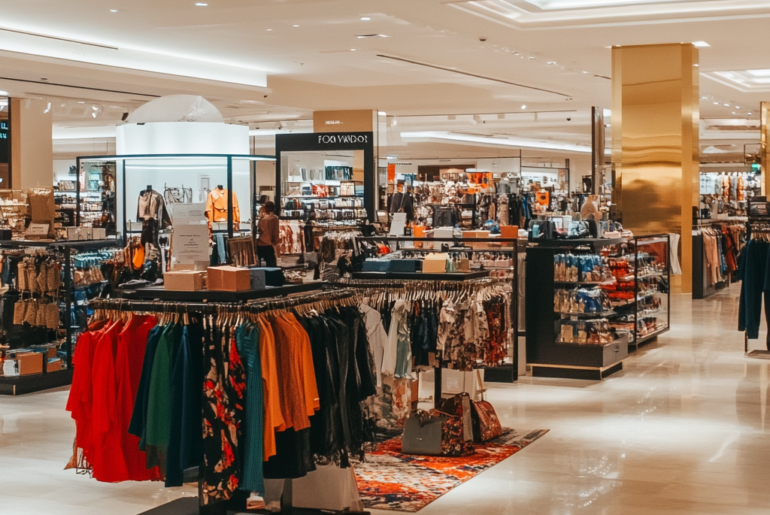This article may contain references to products or services from one or more of our advertisers or partners. We may receive compensation when you click on links to those products or services. Nonetheless, our opinions are our own.
The information presented in this article is accurate to the best of our knowledge at the time of publication. However, information is subject to change, and no guarantees are made about the continued accuracy or completeness of this content after its publication date.
The well-liked fashion retailer Charlotte Russe, which is well-known for its stylish yet reasonably priced clothing, formally declared bankruptcy in 2024. The brand, which was once a mainstay of mall fashion, is currently closing dozens of stores nationwide as it finds it difficult to adapt to changing consumer tastes and the growth of online shopping. Similar to Forever 21’s previous demise, this represents yet another significant setback for fast fashion retail.
You recall the excitement of dressing stylishly for a night out and knowing that you got it for a reasonable price. Offering the newest styles at a reasonable price, Forever 21 was a treasured addition to your wardrobe. But as the retail scene keeps changing, it seems like another hip chain is facing a bleak future. We’ll examine the reasons behind the recent bankruptcy announcement of yet another well-known brand, as well as the implications for the future of fast fashion. You may start to doubt not just the brands you used to love but also the wider ramifications for the retail sector overall as you consider the significance of these changes.
- The Trend of Retail Bankruptcy and What It Means for You
- The Shift in Consumer Behavior: Why Trendy Chains Are Struggling
- Redefining Your Wardrobe: Smart Shopping Strategies Beyond Fast Fashion
- Financial Planning Tips to Prepare for Changing Retail Landscapes
- Investing in Timeless Pieces: Building a Sustainable Wardrobe
- Empowering Yourself: Making Informed Financial Choices in Uncertain Times
- Conclusion
- Frequently Asked Questions
- What led to the bankruptcy of this trendy chain?
- Which trendy chain is facing bankruptcy?
- How does this bankruptcy reflect on the retail industry?
- What are the implications for employees and store locations?
- Are there any plans for the future of the brand after bankruptcy?
- How should consumers respond to this news?
- Recommended Reads
The Trend of Retail Bankruptcy and What It Means for You
A significant shift in consumer habits and market dynamics is reflected in the recent announcement of yet another trendy retail chain filing for bankruptcy, raising eyebrows. With the ease of online shopping and the rise of fast fashion, many stores are struggling to keep their doors open. As you navigate this changing landscape, it’s important to recognize the implications this trend holds for you, both as a consumer and a member of the workforce. Consider the following:
Consumer Choices: Reduced options at brick-and-mortar stores could push you toward online alternatives, affecting your shopping habits and the products you choose.
Job Market Impact: Layoffs and store closures can lead to an increase in competition for positions in your area, influencing job security and prospects.
Investment Awareness: If you have investments in retail stocks or funds, staying informed about these closures may require you to reassess your portfolio.
| Trend | Consumer Impact |
|---|---|
| Shift to Online Shopping | Fewer in-store options; convenience vs. experience |
| Fast Fashion Overload | Pressure on brands to keep prices low; quality concerns |
| Brand Loyalty Decline | Opportunities for new brands; need for adaptability |
You enable yourself to make wise choices regarding your investments, purchases, and career path in this dynamic retail environment by being aware of these trends and their impacts. To successfully navigate these changes, keep in mind that being proactive is important.
The Shift in Consumer Behavior: Why Trendy Chains Are Struggling
Retail has changed significantly in recent years, and this isn’t just a passing fad; it’s a fundamental shift in consumer values and shopping habits. Once praised for their fast fashion and ever-changing inventory, many trendy chains are now struggling to stay in business. Here are a few reasons why:
Value Over Volume: You might find that quality is taking precedence over quantity. Shoppers are increasingly looking for durability and sustainability in their purchases rather than just the latest style.
Rise of E-Commerce: The convenience of online shopping has profoundly altered buying habits. With just a few clicks, you can compare prices and styles, making physical stores less appealing.
Changes in Social Media Influence: Trends now spread quickly but fade just as fast, leading to a cycle of excess inventory that these chains struggle to manage. Influencers might champion a style for a day, but if it doesn’t resonate long-term, it leaves a heap of unsold merchandise.
The economic climate plays a significant role in your purchasing decisions. When budgets tighten, you may find yourself gravitating toward brands that prioritize transparency and ethical production practices. Traditional fast fashion retailers often falter in these areas, pushing you toward more responsible choices. The implications for these once-popular brands are significant; they must adapt quickly to a new consumer mindset or risk becoming another statistic in retail bankruptcy.
Redefining Your Wardrobe: Smart Shopping Strategies Beyond Fast Fashion
As the fashion industry faces continual shifts, it’s important to rethink your shopping habits and invest in pieces that offer longevity and versatility rather than succumbing to the fleeting trends of fast fashion. By taking a more thoughtful approach, you can create a wardrobe that not only reflects your personal style but also endures over time. Here are some strategies to consider:
Quality Over Quantity: Focus on investing in well-made garments that are crafted from durable materials. These will not only last longer but also frequently provide better value over time.
Capsule Wardrobes: Consider creating a capsule wardrobe filled with a few timeless essentials that can be mixed and matched. This minimizes clutter and ensures that you always have something stylish to wear.
Second-hand Shopping: Explore thrift stores, consignment shops, and online marketplaces for pre-owned fashion. This is not only budget-friendly but also environmentally conscious.
Plan Your Purchases: Before heading out, assess what you truly need. Create a list that considers your lifestyle demands, helping you avoid impulse buys.
By following these simple yet effective strategies, you can redefine your clothing collection to be more sustainable and reflective of your unique taste. Remember, each thoughtfully chosen piece not only enhances your wardrobe but also contributes to a shift away from the disposability of fast fashion.
Voted "Best Overall Budgeting App" by Forbes and WSJ
Monarch Money helps you budget, track spending, set goals, and plan your financial future—all in one app.
Get 50% OFF your first year with code MONARCHVIP
Financial Planning Tips to Prepare for Changing Retail Landscapes
As you navigate today’s rapidly evolving retail environment, it’s important to reassess your financial strategies. Consider these steps to bolster your financial health in light of industry shifts:
Diversify Your Investments: Avoid concentrating all your assets in one area. Explore a mix of stocks, bonds, and ETFs that reflect a range of sectors, including those that thrive in times of retail uncertainty.
Revisit Your Budget: With many retailers facing financial challenges, your discretionary spending habits may need an overhaul. Identify areas where you can cut back, especially in non-essential retail purchases.
Create an Emergency Fund: Aim to save at least three to six months’ worth of living expenses. This will provide a cushion for unexpected changes in employment or increases in costs due to inflation.
Monitoring changing consumer behavior can guide your decisions. Here’s a simple breakdown of factors to consider:
| Factor | Implications |
|---|---|
| Online Shopping Growth | Invest in companies that leverage e-commerce, as consumers prefer online. |
| Localism Trend | Support local businesses and consider investing in community-focused enterprises. |
By proactively adjusting your financial plans now, you’ll be better positioned to navigate the unpredictable retail landscape.
Investing in Timeless Pieces: Building a Sustainable Wardrobe
In a world dominated by fast fashion and fleeting trends, curating a wardrobe filled with timeless pieces not only elevates your style but also promotes sustainability. When you shift your focus to investing in quality over quantity, you contribute to reducing the environmental impact of the fashion industry. Consider creating a collection of essentials that can withstand seasonal fluctuations, enabling effortless mixing and matching. Here are some categories to consider for a sustainable wardrobe:
Classic Denim: A well-fitting pair of jeans can last for years and can be dressed up or down.
Tailored Blazers: Perfect for both professional settings and casual outings.
Little Black Dress: A versatile staple that fits any occasion with the right accessories.
Quality Footwear: Invest in shoes that offer comfort and durability, like leather boots or classic loafers.
Neutral Basics: A selection of t-shirts and sweaters in neutral colors that pair well with anything.
To further illustrate how moving away from disposable fashion benefits both your wallet and the planet, consider a simple table comparing the costs and impacts of fast fashion with timeless investments:
| Fast Fashion | Timeless Investment |
|---|---|
| Low-quality materials lead to fast rips | Durable fabrics that withstand wear and tear |
| Trendy items with limited wearability | Versatile pieces that never go out of style |
| Frequent purchases lead to financial strain | Fewer purchases save money in the long run |
By making conscious choices in what you buy, you not only enhance your personal style but also embrace a lifestyle that values sustainability. As companies face bankruptcy due to unsustainable practices, now is the perfect time to pivot and invest in a wardrobe that reflects your values and supports a more responsible future.
Empowering Yourself: Making Informed Financial Choices in Uncertain Times
Taking charge of your financial future is more important than ever in the current uncertain economic environment. It is urgent that you reevaluate your financial practices and decisions in light of the recent bankruptcy filing of another popular retail chain. Consider taking these concrete actions to empower yourself rather than just riding the wave of uncertainty:
Evaluate Your Spending: Take a close look at your current spending habits. Are you spending on non-essentials that can be trimmed back? Building a budget can help you identify areas where you can save.
Prioritize Emergency Savings: Experts recommend having three to six months’ worth of expenses saved. It acts as a cushion during uncertain times, giving you peace of mind.
Diversify Your Income Streams: Consider exploring side gigs or freelance opportunities to diversify your income. This not only adds to your financial stability but can also make you more resilient to shifts in the job market.
To further guide your decision-making, here’s a simple overview of potential expenses to evaluate:
| Expense Category | Actionable Steps |
|---|---|
| Groceries | Consider meal planning to reduce impulse purchases. |
| Subscriptions | Review recurring subscriptions and eliminate unused ones. |
| Dining Out | Limit dining out to once a week to save money. |
Making educated decisions is essential during uncertain times. You can increase your financial resilience and prosper even in less than ideal situations by actively managing your money and looking for new opportunities.
Conclusion
Charlotte Russe’s bankruptcy demonstrates the continuous upheaval in the retail industry, as established mall brands find it difficult to compete with flexible e-commerce platforms and shifting consumer preferences. Traditional fast fashion models are coming under more and more pressure as consumers choose sustainable fashion, digital convenience, and quality over quantity.
This shift emphasizes for consumers the value of budgeting carefully, creating adaptable wardrobes, and promoting ethically minded companies. It alerts workers and investors to the need to diversify portfolios, keep an eye on retail trends, and get ready for labor shifts brought on by store closures.
This incident is a warning and a call to change, whether that means adopting new retail models, reevaluating wardrobe strategies, or modifying financial plans. Being knowledgeable and proactive is the best course of action in a retail environment where only the most adaptable players thrive.
Frequently Asked Questions
What led to the bankruptcy of this trendy chain?
The bankruptcy was primarily driven by ongoing financial struggles, increased competition, and shifts in consumer behavior. The rise of online shopping and changing fashion trends made it difficult for the chain to maintain profitability.
Which trendy chain is facing bankruptcy?
The trendy chain in question is Charlotte Russe, known for affordable and stylish apparel aimed at younger women. It developed a loyal following over the years but has struggled to remain profitable in the current retail climate.”
How does this bankruptcy reflect on the retail industry?
This bankruptcy highlights the significant challenges faced by brick-and-mortar retailers in today’s digital age. It underscores the need for businesses to adapt to rapidly changing consumer preferences and the importance of establishing a robust online presence.
What are the implications for employees and store locations?
With the closure of locations, many employees will face job losses or transitions to new positions. Store closures may also impact local economies, reducing foot traffic and the overall vibrancy of shopping districts.
Are there any plans for the future of the brand after bankruptcy?
While specific plans post-bankruptcy have yet to be outlined, companies often seek to restructure and emerge stronger. This could involve focusing on e-commerce, revising their product lines, or exploring new markets.
How should consumers respond to this news?
Consumers may want to take advantage of any sales or clearances as the chain winds down its operations. It’s also a moment to reflect on their shopping habits, considering the trends in the retail industry and supporting brands that align with their values.

Reviewed and edited by Albert Fang.
See a typo or want to suggest an edit/revision to the content? Use the contact us form to provide feedback.
At FangWallet, we value editorial integrity and open collaboration in curating quality content for readers to enjoy. Much appreciated for the assist.
Did you like our article and find it insightful? We encourage sharing the article link with family and friends to benefit as well - better yet, sharing on social media. Thank you for the support! 🍉
Article Title: Forget Forever 21: Another Trendy Chain Shares Bankruptcy Closing
https://fangwallet.com/2025/07/22/forget-forever-21-another-trendy-chain-shares-bankruptcy-closing/The FangWallet Promise
FangWallet is an editorially independent resource - founded on breaking down challenging financial concepts for anyone to understand since 2014. While we adhere to editorial integrity, note that this post may contain references to products from our partners.
The FangWallet promise is always to have your best interest in mind and be transparent and honest about the financial picture.
Become an Insider

Subscribe to get a free daily budget planner printable to help get your money on track!
Make passive money the right way. No spam.
Editorial Disclaimer: The editorial content on this page is not provided by any of the companies mentioned. The opinions expressed here are the author's alone.
The content of this website is for informational purposes only and does not represent investment advice, or an offer or solicitation to buy or sell any security, investment, or product. Investors are encouraged to do their own due diligence, and, if necessary, consult professional advising before making any investment decisions. Investing involves a high degree of risk, and financial losses may occur including the potential loss of principal.
Source Citation References:
+ Inspo
There are no additional citations or references to note for this article at this time.












































